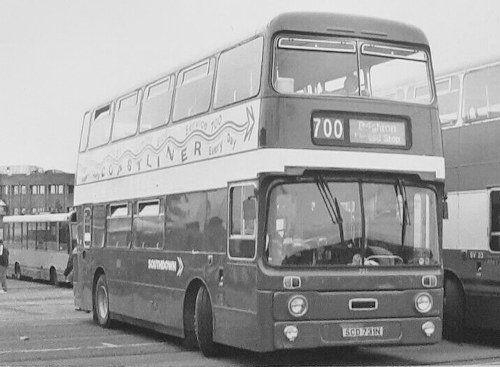Leyland Atlantean AN type Bus
 |
|
|
Manufacturer |
Leyland Motors |
|
design type |
double-decker bus |
|
Production period |
1958 to 1986 |
|
engine |
Leyland O.600 / O.680 / O.690 |
|
length |
30 ft = 9.14 m |
The Leyland Atlantean AN was a double-deck bus built from the 1950s to the mid 1980s.
History
Leyland began testing designs for a rear-engined double-decker bus in 1952. Charles H. Roe created a prototype with a body that measured 7 feet 6 inches (2.29 metres) at the time. The turbocharger for the Leyland O.350 diesel engine was located on the back of the subframe. The platform frame comprised steel side rails and other light metal pieces. A pneumatically operated circuit manufacturer SCG installed an automated clutch and a Vorwähl transmission. PDR1 was the name of the vehicle with the number 530001. (R for rear-engined, rear engine).
1956 was a second prototype, no. 542209, this time with a body made by Metro Cammell Weymann . This had a centrifugal clutch and a bevel gearbox with pneumatically assisted gearshift. This vehicle was 4.03 meters high with a 4.94 meter long wheelbase with a total length of 9.09 meters and had 78 seats. Leyland called the prototype lowloader . Although two prototypes were extensively tested, the same problem remained with the front-engine buses: the entrance was at the back and the space next to the driver remained unused.
Leyland Atlantean was a chassis built by Leyland Motors between 1958 and 1986 for double-decker buses . The superstructures came from different manufacturers . Leyland was a pioneer in the production of double-deck buses with rear engine and front entry for one-man operation. The conductor, who transmitted the departure signal from the rear part of the vehicle to the driver and collected the fare was now no longer needed. After 1986 Volvo acquired the Leyland bus division, the production of Atlantean was discontinued and the Leyland Olympian was now the only double-decker bus from Leyland.
In February 1972, the AN68 series replaced the PDR1 / PDR2 models. The new chassis allowed for a wider door and provided some new safety features. An audible and visual alarm informed the driver in time of impending overheating of the engine. A fail-safe brake was introduced and the steering box and brakes were protected against damage during severe frontal collisions. For greater corrosion resistance now stainless steel tubes were used.
Two models were offered: AN68 / 1R with 9.4 m length and AN68 / 2R with 10.2 m length. Power steering was standard on the AN68 / 2R and optional on the AN68 / 1R. The only available engine was the new Leyland O.680 diesel engine. A variety of body styles from different manufacturers were still offered, so the Atlantean was also tailor made to meet the needs of small independent operators with different needs than the corporations from major cities.
From 1978 Leyland offered the AN69 with the Leyland O.690 diesel engine, a variant of the O.680 with turbocharger , which was mainly ordered in the export models.
The Atlantean continued to be sold in large numbers and many customers remained true to the model. Above all, however, London Transport (LTE) opted for the Daimler Fleetline (later Leyland Fleetline ) with special equipment rather than for the Atlantean as their large rear-engined double decker. These proved to be technically vulnerable and required special maintenance.
By the end of production over 15,000 Atlanteans were built. Greater Manchester PTE was the largest operator of Atlantean fleets with bodies from Northern Counties Motor and Engineering Company and to a lesser extent Park Royal Vehicles . This was followed by Glasgow PTE with superstructures predominantly by Walter Alexander Coachbuilders . The third largest fleet operated Merseyside PTE with approximately 800 vehicles mostly carved by Walter Alexander Coachbuilders and East Lancashire Coachbuilders , along with smaller batches with superstructures from Metro Cammell Weymann and Willowbrook, Notably, Atlantis' fourth largest customer was Singapore Bus Service with 520 Atlantean AN68 / 2Rs between 1977 and 1986 in three batches with Duple Metsec , British Aluminum Company and Walter Alexander Bodyworks. The Singapore-based Leyland Atlanter were decommissioned by 2001 .
Manuals
-
Leyland Motors Ltd Previous 2 / 40 Next
